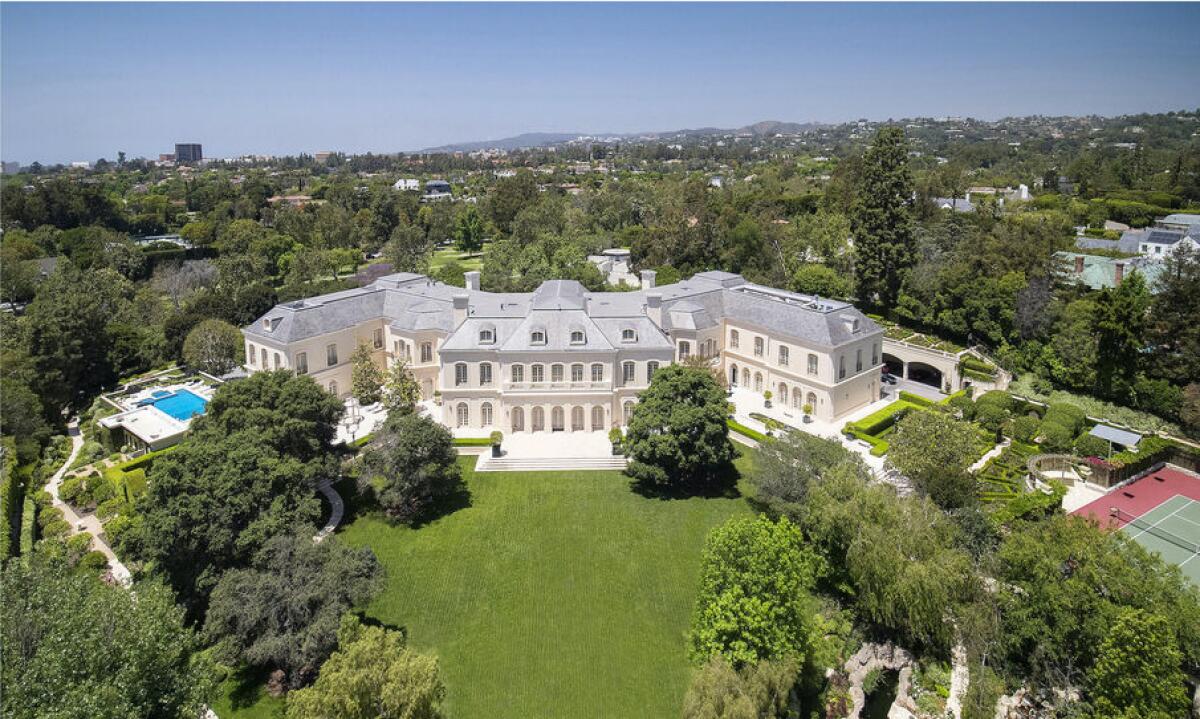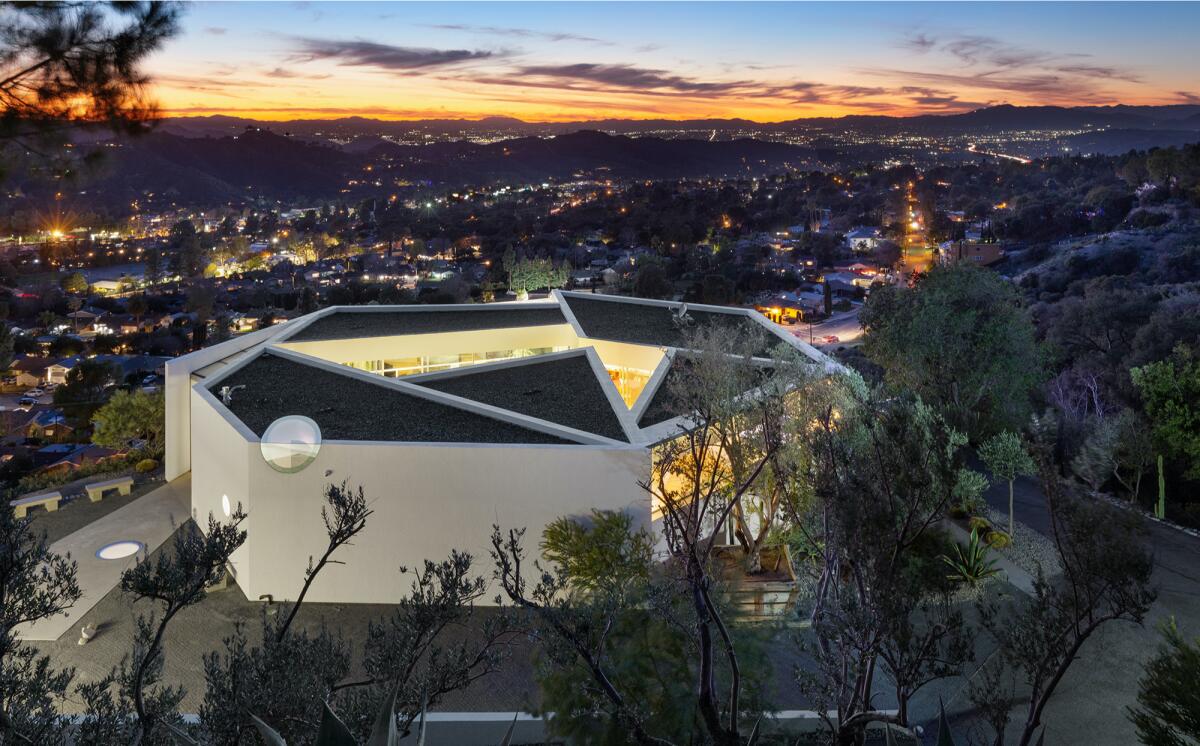Real Estate newsletter: Candyland mansion chases sweet $165 million

- Share via
Welcome back to the Real Estate newsletter. Before we get into it, a quick shout-out to the Rams, who made housing news by winning the Super Bowl and turning all of L.A. into “RAMS HOUSE” — or “HAMSHOOSE,” or maybe “RAMSYWUSE.”
The laughable Hollywood sign makeover is an classic example of the maxim, “A good idea poorly executed is a bad idea.”
More than 100 million people tuned into the Super Bowl on Sunday, making it SoFi Stadium’s biggest coming-out party to date. The 3.1-million-square-foot complex is a stunner, and if you’re curious about the architectural history, The Times looked into who built it and what makes it so special.
In the luxury market, the week’s biggest listing arrived in Bel-Air, where a mansion called the Manor is looking to make history once again. After setting the all-time price record when it sold for $119.75 million in 2019 (since surpassed a few times), it’s chasing an even bigger sum this time around: $165 million.
If it gets its price, the home — built by producer Aaron Spelling and wife Candy and nicknamed Candyland — will tie a purchase by Jeff Bezos for the second-priciest home sale in Southern California history.
We don’t check in on La Crescenta enough, but every time we do, the small, hillside community makes it worth our while. The area’s notable listing comes from Red Hot Chili Peppers bassist Flea, who’s asking $9.8 million for his compound that comes with a house designed by Richard Neutra and a seven-sided futuristic structure. You really need to see the amazing photos on this one.
Now time for some news you can use, if you’re looking to buy a home: Mortgage rates are surging. Costs for 30-year loans rose to a two-year high of 3.69% last week, or 20% higher than they were at Christmas. The trend may bring an end to a red-hot market that was fueled in large part by historically low mortgage rates, which gave buyers significantly more purchasing power.
Insurance rates are also soaring, especially for homes in fire-prone areas of California. If you live or are looking to live in such a place, we built a road map for you to follow to help save on insurance, because multiple insurers offer discounts to homeowners who’ve made fire-related safety improvements to their properties.
While catching up on the latest, visit and like our Facebook page, where you can find real estate stories and updates throughout the week.
SoFi Stadium, explained

SoFi Stadium began allowing fans into the site last spring, but Sunday’s Super Bowl LVI was in many ways the venue’s true debut. And what a debut it was, writes Carolina A. Miranda.
The 3.1-million-square-foot, $5-billion arena has plenty of superlatives attached to it. It’s the largest stadium in the NFL. It’s the league’s first indoor-outdoor stadium. And the stands’ steep vertical pitch allows fans to get startlingly close to the action. Hell, if you bathe in money and can afford one of the field cabanas, you could very well have a defensive lineman land in your beer.
SoFi comes courtesy of a team of more than eight dozen architects and designers led by Lance Evans of HKS, a global architectural firm with offices in Los Angeles. The mission at SoFi was to come up with great experiences “at every price point,” Evans said.
The Manor chases history

In 2019, the Manor pushed Southern California’s luxury real estate market to new heights when it sold for $119.75 million. At the time, it was the priciest sale ever in L.A. County.
Now, the estate is back up for grabs with an even bigger price tag: $165 million.
When someone spends more than $100 million on a home, their identity usually trickles out at some point, but the Manor’s owner remains unknown. Records show it was purchased by a California-based limited liability company called 594 Mapleton, but the entity behind the company is a mystery.
Flea lists a hillside gem

Plenty of stellar homes dot the hills of La Crescenta, but none of them look quite like Flea’s. The Red Hot Chili Peppers bassist has owned the futuristic compound for four years, and now he’s shopping it around for $9.8 million.
That’s more than double what Flea, whose real name is Michael Balzary, paid in 2018. Records show he bought it from artists Lari Pittman and Roy Dowell for $4.25 million and made a few additions, including a chic cabin, 50-foot-long swimming pool and 875-square-foot addition during his stay.
At the center of the 5.7-acre spread sits a swirling, seven-sided structure and a smaller house built in 1953 by famed architect Richard Neutra for his secretary, Dorothy Serulnic. Neutra’s best work combines modernism with indoor-outdoor Southern California living, and that design philosophy is on full display here.
Buyers beware: mortgage rates are jumping

First-time home buyers, already getting clobbered by bidding wars, now face a potential knockout punch: higher mortgage rates.
Costs for 30-year loans hit a more than two-year high of 3.69% in February, rising about 20% just since Christmas. Further increases are expected as the Federal Reserve, trying to curb inflation, hikes its benchmark rate. That’s a daunting prospect for entry-level buyers when affordability is already at its worst since 2018, write Prashant Gopal and Jo Constantz.
The pandemic housing rally is heating up again as the key spring selling season approaches, threatening to push new buyers beyond the brink of what they can pay. Their modest incomes put them at a disadvantage when competing against downsizing seniors and single-family landlords for the same moderately priced houses. The jump in borrowing costs is sapping their purchasing power, preventing them from bidding high enough to have a chance.
How to save on home insurance
With the fire season growing longer and wildfires increasing in intensity, Californians living in fire-prone areas are having a harder time finding affordable insurance for their homes — if they can find coverage at all, writes Jon Healey.
With that in mind, state officials unveiled a “Safer from Wildfires” framework this week for improving fire safety and reducing losses. The goal is not just to save lives, but also to hold down premiums and make coverage available in more areas.
The framework lays out a list of upgrades that individual homeowners should make and preventive actions that local governments and community groups should take. Rather than breaking new ground on fire safety, it draws from the best practices outlined by the consumer group United Policyholders, the Insurance Institute for Business & Homes Safety and Cal Fire, among others.
What we’re reading
Fortune has an ominous warning with a headline promising that “the spring 2022 housing market will absolutely crush buyers.” The story cites Zillow numbers that claim housing inventory will be significantly below previous estimates, which prompted the home-selling website’s prognosticators to change their minds about home price growth. Instead of showing slower annual growth, prices will go up even more in 2022 than in 2021, Zillow data indicate.
Last year, investors bought 10% of all homes in the L.A. area, which wasn’t enough to crack the top 10 among 40 major metropolitan areas analyzed by the Washington Post. The Post analysis, using Redfin data, found that investors bought nearly 1 in 7 homes sold in top U.S. metro areas, the most in at least 20 years, with Black neighborhoods and Southern cities disproportionately affected. An interactive map of Los Angeles shows investor purchases were brisk (48%) in University Park, which houses USC, but also in affluent areas such as Malibu and Beverly Hills, which saw a third of homes scooped up by investors.
Inside the business of entertainment
The Wide Shot brings you news, analysis and insights on everything from streaming wars to production — and what it all means for the future.
You may occasionally receive promotional content from the Los Angeles Times.




